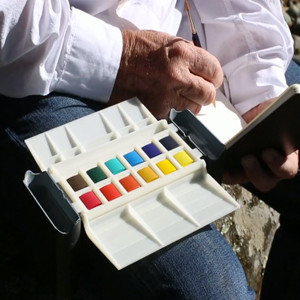Larry D. Marshall's Blog, page 45
November 23, 2016
I’m Back Drawing Soapstone
[note: this was done last week but I forgot to press the publish button]
We returned to the museum of civilisation on Thursday and I continued sketching Inuit soapstone carvings. These are not precise carvings but they have a smoothness about their surfaces that is impressive when you realize they’re generally done by hand. More importantly, traditional Inuit carving is a form of story-telling, a reflection of Inuit life.
I started a two-page spread in my Stillman & Birn 8×10 Beta softcover book but only got the central sculpture done. It depicts a family’s successful hunt.
 Sorry about the poor photo. I found it impossible to scan a two-page spread and didn’t have lights set up to photograph it properly.
Sorry about the poor photo. I found it impossible to scan a two-page spread and didn’t have lights set up to photograph it properly.
November 20, 2016
Domestic Sketching: Let’s Try Imagining A Pine Tree
It seems there will be a continuing series of sketches being done by this urban sketcher that have nothing to do with urban sketching. I’m forcing myself to draw at my desk. I’ve even cleaned it off so I don’t have to shove stuff out of the way to do it. I’m going to call this domestic sketching and label results as such.
Anyways, my first sketch was a small, defoliated tree and I thought it only fitting that I should follow it up with a pine tree. As it turned out, I drew two of them, the second coming simply because I wanted to try to do a classic Christmas tree shape. Probably shouldn’t have cuz it looks out of place in this sketch, at least to me. One thing I’ve noticed about sketching at home, with good light, a desk and a good chair. The sketching is a whole lot easier.

Fabriano Artistico (7.5×11), Pilot Falcon
November 18, 2016
When It’s Cold, Sketch Quickly
We are getting a reprieve from the relentless march into winter. We’ve had a couple days where the temps have gotten up to 6-7C (low 40s for the metric-challenged). It’s also been very windy but yesterday the winds dropped to a reasonable level and I just couldn’t pass up the possibility of doing some outdoor sketching.
I decided to go armed with quick-draw (pun intended) materials so I took a couple of 10×14 Coroplast sheets, cut some 6×9 sheets of cheap multi-media paper, and I taped two sheets on each side of the coroplast. These were shoved into my bag and out the door I went. The idea was that I needed to do sketches quickly so I didn’t have to sit for a long period, which cause my old Arizona bones grow cold and I get grumpy.
I managed to get a couple sketches done with considerable walking in between, each sketch taking only 15 minutes or so. I applied the color at home. Hope you like them. For me it was a major victory and gives me some hope that I’ll be able to do some outdoor sketching using this method. As it gets colder I can shift more and more towards Marc Taro Holmes’ “5to7 sketches” where you use 5-7 lines to do sketches very quickly. Where there’s a will, there’s a way.
November 17, 2016
The Saga Of A Sunday Sketchcrawl
Last Sunday was our monthly sketchcrawl. We were to meet at a historic house, the Maison Alphonse-Dejardins, on the south shore of the St. Lawrence River in Levis. I was excited to visit the place and thankful that Yvan had arranged for us to sketch there.
Early Sunday morning, I set out on a walk to the ferry that took me just a bit less than an hour. The ferry took 10-15 minutes to cross and then I had to climb a cliff (a gazillion stair steps are provided) and then into the older part of Levis where the house resides. I was there at 10AM. The air was crisp, which is a fancy way of saying I was glad I was wearing gloves, but I knew that people would be showing up soon.
But they didn’t. Nobody came. In fact, the house itself was dark. I began to wonder if I’d written the date wrong. Cell phones are handy at such times and the website announcement made clear my error. Because of the house’s Sunday schedule, it didn’t open until the afternoon so the sketchcrawl was scheduled for 1PM. @#%$!!
And so I walked to the stairs, descended the cliff and walked to the ferry. I crossed the St. Lawrence and walked home. I didn’t do the math, though, and when I arrived at home I realized that to get back to Levis by 1PM, I’d have to leave in… about 10 minutes [sigh].
I gave some thought to not returning but being the devoted sketcher (or fool – you decide) I put my coat back on and headed out the door…to walk an hour, take the ferry, climb the cliff, and make my way to the house. I made it but since I’d been on the move from 8:30 to 13:00, I was exhausted and wasn’t much in the mood to sketch. I just wanted to sit down.
The house, though, is sketcher heaven if you like sketching items you’d find in a Victorian house. It’s a place I’ll be going to several times this winter for just that reason. But on this day I found myself in the kitchen and in one corner there was a wooden, hand-agitated washing machine. It had been semi-restored as a display piece but the staves that made the body of the machine had been glued together and the metal bands that would normally hold everything together were placed, somewhat askew, just for show.
I couldn’t look at it without seeing it as a cartoon and so, channeling Gary Larsen as best I could, I drew it as such. It’s not my best work but I had fun doing it which is my criterion for success. And I only had one more trip between the Maison Alphonse-Dejardins and my place. I went to bed early that night.
November 16, 2016
Drawing Trees In The Morning
I mentioned that I’m trying to get myself drawing at home rather than on the street. It sure is a struggle and I’ve definitely got to get a place set up to do it. But I’m pretty good at the clear-the-deck arm sweep that will shove a bunch of stuff out of the way and provide me a place for some paper.
That’s what I did the morning I decided to draw a clump of foliage. Notice that I’m not setting my sites too high. I have to convince my brain that it should be drawing in the morning while I’m having my morning coffee and I don’t want to discourage it. I did upgrade my paper, though. This one was done on Fabriano Artistico CP, which may be a bit to rough for my fine fountain pens but we’ll see.

Platinum 3776 SF, Platinum Carbon Black
One thing is clear. It’s a LOT easier to draw and paint in a studio with the paper resting on a flat surface. Heck, it’s not even windy (grin).
November 15, 2016
Portable Palette Campaign On Indiegogo
Hey everybody, take a look at this. It’s a nifty travel palette that packs up small, provides two nice water holders and it fits over your leg so you don’t have to hold it when you paint. It’s part of an Indiegogo campaign so I pledged to get one. It’s worth a look. There are a bunch of photos, including a series of their prototype.
https://www.indiegogo.com/projects/portable-painter-painting-travel#/
November 14, 2016
Off To Sketcher Museum Land
While our Museum of Civilization doesn’t have much to offer a sketcher this winter, it is pretty much the only game in town so a group of us were there, trying to take stock of sketching subjects for winter.
I’ve decided that I will sketch a bunch of the Inuit soapstone carvings because 1) they are available and 2) they offer lots of compound curves and soft edges to challenge my drawing skill. Hopefully I’ll get better at them but until then, here are a couple that I did on Thursday. Stillman & Birn Alpha (5.5×8.5) softcover.

This is an Inuit hunter, hiding behind a hide-covered shield, trying to sneak up on a seal.

This one speaks volumes about the rigors of living in the extreme north. This woman, wearing a parka and gloves is shown giving birth. That’s tough work if ever I’ve seen it.
November 13, 2016
Book Review: Designing Creatures & Characters by Marc Taro Holmes
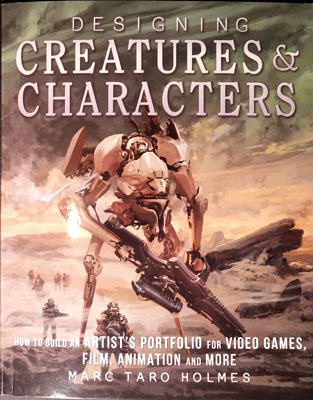 From the title of this post you might be wondering if I’ve gone mad. You might be asking “What does Designing Creatures & Characters have to do with being a street sketcher in Quebec City?” Truth is, I bought this book because of the words at the bottom of the cover, Marc Taro Holmes. I’m a big fan. I love his art and because he’s so giving of his time and expertise online, if he’d illustrate the Quebec phone book I’d buy one, and I never call anyone any more.
From the title of this post you might be wondering if I’ve gone mad. You might be asking “What does Designing Creatures & Characters have to do with being a street sketcher in Quebec City?” Truth is, I bought this book because of the words at the bottom of the cover, Marc Taro Holmes. I’m a big fan. I love his art and because he’s so giving of his time and expertise online, if he’d illustrate the Quebec phone book I’d buy one, and I never call anyone any more.
This book is about how to become a concept artist, working in an animation studio. I know nothing of that world and I figured I’d get this book, flip through it, enjoy the pictures and put it on a shelf. But I found myself reading it, cover-to-cover, gleaning little bits and bobs while learning how character development works in the minds of people with imagination. Wish I had some (grin).
What I have to confess is that I’m not in a position to review this book. It’s beautiful but beyond that, I’m out of my depth. The book is divided into four sections: Ideation, Anatomy, Animation, and Illustration. Each section presents information about its subject and then there are nine projects for the reader to accomplish. It might be to develop a set of fishes inhabiting the sea in a video fishing game or development of a group of possibilities for a warlord character. One project is the development of a crew of a pirate ship.
Each of the major sections builds on its predecessors and eventually you are at a point where you have fully-rendered characters, drawings showing detailed construction information, and drawings showing how the character moves and any special features of said character. It’s all pretty cool.
To be honest, I got the most from the Ideation section. This section is closest to what I do. It’s sketching and in this case, it’s sketching in the form of brainstorming ideas, dumping as many as you can on the page so they can be visualized and evaluated. This was where I surprised myself because I found myself scribbling copies of some of those sketches and I had a ball doing them. I even started adding stuff to those sketches, or removing things. To be sure, I would have been laughed out of any concept director’s office but it was fun nevertheless.
 I’m not a fan of digital rendering as it all looks the same to me so when the book ventured further into a concept artist’s process, the book sort of lost me. All I could do was look at the pictures because I have no idea how to digitally render a cube, let alone complex creatures. I wish I could say more about this book but, quoting Clint Eastwood, “A man’s gotta know his limitations.” What I can say is that IT’S A MARC TARO HOLMES BOOK and I love it.
I’m not a fan of digital rendering as it all looks the same to me so when the book ventured further into a concept artist’s process, the book sort of lost me. All I could do was look at the pictures because I have no idea how to digitally render a cube, let alone complex creatures. I wish I could say more about this book but, quoting Clint Eastwood, “A man’s gotta know his limitations.” What I can say is that IT’S A MARC TARO HOLMES BOOK and I love it.
November 11, 2016
Urban Sketcher Going Into Hibernation
I’ve talked about how hard it is for me to transition from street sketcher to indoor sketcher every winter and that saga continues. I’m starting to think, though, that my situation this year is a bit different. I say this because the depth of my ‘doldrums,’ as I’ve called them are far deeper than normal and I believe the reason is that I’m also at a point where I want to shift gears a bit, take it up a notch, move outside my comfort zone, or whatever euphemism fits.
As the summer has worn on I’ve also started thinking about watercolors beyond using them like crayons and I want to learn how how those brush things work. I’ve been so concentrated on learning to draw that I’ve completely ignored color, viewing it as an after-the-fact thing. I also want to extend/expand my visual brain, improving my visual memory, textures vocabulary, ability to see half-tones, etc. This stuff is hard and requires at a shift in my activity. Couple this with the outdoor->indoor shift that’s taking place at this time of year and my poor, very old brain, is just a bit confused, maybe even intimidated. Getting it to act seems hard right now.
I talked a bit with my buddy Yvan and he suggested that I get up in the morning and do “something simple.” He’s also been telling me forever that I should draw from imagination, not by drawing dragons but by drawing things I’ve seen, or at least representative of things I’ve seen. He suggests this will change the way I see the things I draw even when I’m on location. Since he’s rarely been wrong when it comes to things “art,” I think he’s right about this as well.

Note the wrinkles as the photocopy paper rebelled against the quick swipes of watercolor
And so, this morning, I got up, grabbed a piece of photocopy paper (does this mean I haven’t completely bought into the idea?) and I did a quick drawing of a lamppost coming out of a pile of sunflowers that I saw on Ile d’Orleans this summer. I’m sure it’s not completely accurate but I think it’s close to the real thing. Most of all, I felt a process I’ve never felt before, a questioning of how big/small things were, how one thing related to another and I think this is the stuff Yvan was talking about.
I sipped some coffee and thought some about what I’d just done, which in turned caused me to grab another sheet of photocopy paper and I started doing really quick sketches of the lamp using a bunch of different pens. No attempt was made to be accurate as mostly I was thinking about how each pen felt and what kind of line did it make. I include it here just to document this journey, not that it is anything worthy of looking at.
Winter may not be such a bad thing for me at this point. I’m going to try to set up a “studio,” which for me amounts to having some sort of uncluttered surface and I’m going to experiment, draw from memory, and maybe even train my visual memory. I’m starting to get excited by the prospects.
Oh…while I’m writing, here’s a quick sketch I did from Marc Taro Holmes new book on being a concept artist. Marc’s version is much better (grin). I hope to talk about this book soon.
November 8, 2016
Trying To Sketch Cirque D’Soleil Wannabes
[Note: I wrote this last week and forgot to push the “publish” button. Here it is, albeit it’s a bit of old news]
Once a year I have a very humbling sketching experience. Actually, I have a lot of those but this annual event is particularly impactful. A group of us go to the local École de Cirque, a circus school in an old church, to sketch the circus students while they practice. Quite separate from sketching, it’s a very exciting time because the main hall is full of trampolines, trapezes, and open areas where these very talented people practice their trade. If nothing else it informs your brain that hard work is the road to being “talented.”

Done with Lamy ink, melted with a waterbrush. These were ‘warm ups’ done before we actually entererd the hall.
For me to begin sketching at the École de Cirque is hard for two reasons. The first is that I’m simply mesmerized by what is before me. There was a juggler who was balancing a ring on his head while juggling several other rings, passing smaller ones through the ring on his head as he juggled. He was amazing.
The other reason I have a hard time is that it’s just soooooo hard. I’m not good at sketching people anyway, but I can hold my own when sketching people who are sitting or standing and I even have a good chance at capturing people wandering around in a shopping center. In all these cases, though, I have points of reference. Feet on the ground, heads above feet… at least that. But in the case of circus performers I don’t even have that and I get very confused, very quickly.
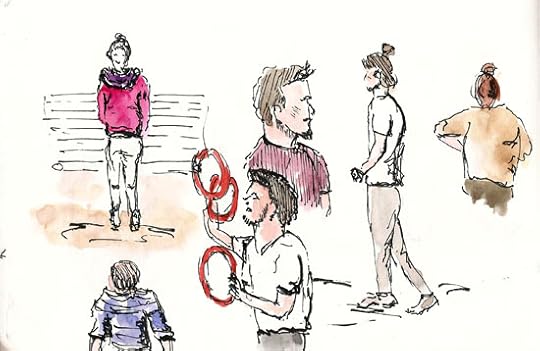
I switched to a Duke 209 (fude pen) and waterproof ink. I struggle with fude pens but wanted to give them another try. Color was added after the fact and in somewhat haphazard fashion I confess.
There’s another thing and I wonder if I’m the only one who struggles with this. I can’t convince my brain that I actually have time to sketch these people. My brain seems to decide that if I can’t do the sketch in 10-15 seconds, I can’t do a sketch, which is untrue, even with the performers moving around so much. But my brain directs me to give up completely on size and proportion estimation and to just start scribbling – the end result being people that look like space aliens or melted people. I’m sharing some of these with you as an example of poor sketches that were a lot of fun to do. Too often I think fun and product get tied too closely together by many. They have nothing to do with one another.

Stillman & Birn Alpha softcover (5.5×8.5) sketchbook was used for all these sketches. I really love this format for doing this sort of sketching.
Somehow, during the page above I decided that a divide and conquer strategy was in order, or maybe I was just fascinated how the well-muscled athletes provided a great opportunity to do “life drawing” while muscles were being exercised. That turned out to be a lot of fun.
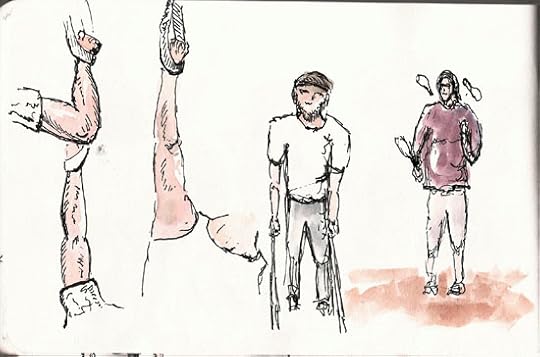
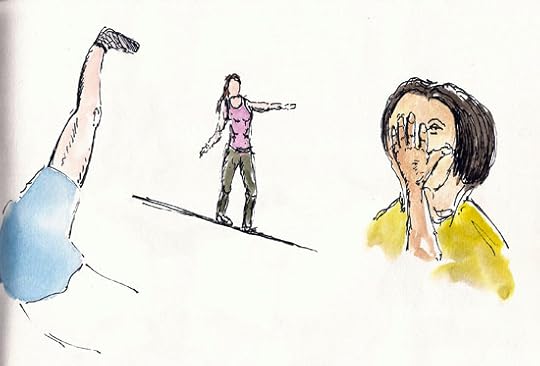
 In the end, I had a bunch of sketchbook pages and memories. Memories of how amazing these people were; memories of how hard it was for me to draw them, and memories of how much fun sketching is even if it’s not going as well as I’d like. I thought it only fitting for me to share these pages with you. I hope all of you are saying “I can do better than that” (grin)
In the end, I had a bunch of sketchbook pages and memories. Memories of how amazing these people were; memories of how hard it was for me to draw them, and memories of how much fun sketching is even if it’s not going as well as I’d like. I thought it only fitting for me to share these pages with you. I hope all of you are saying “I can do better than that” (grin)





